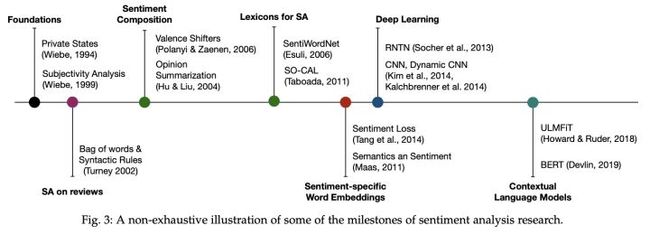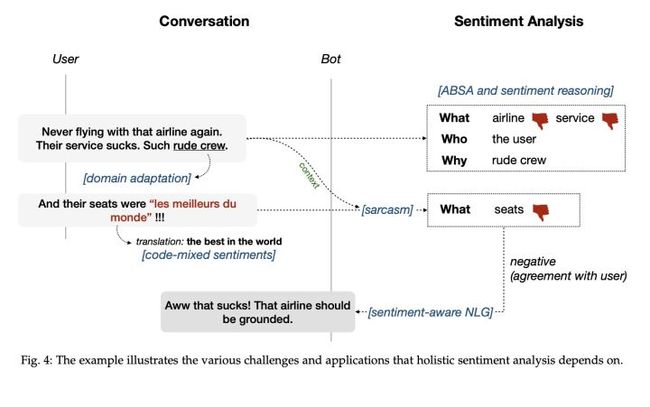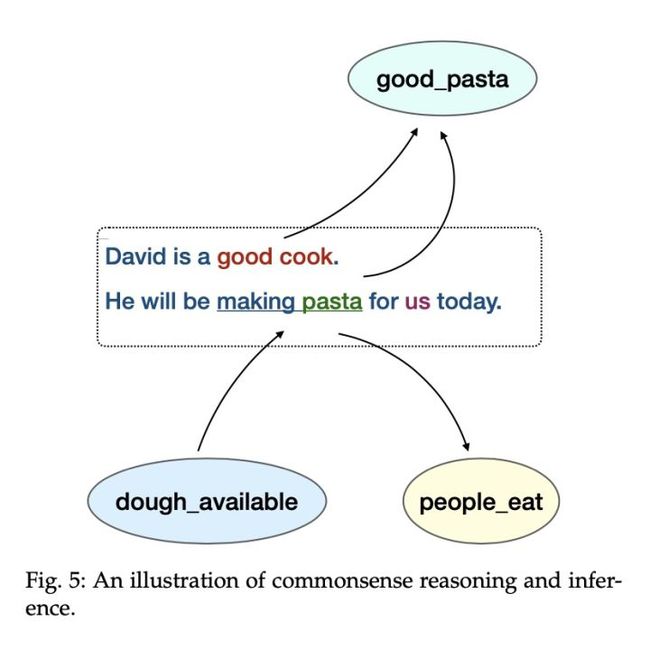情感分析研究:还未结束!
本文提炼自“Beneath the Tip of the Iceberg: Current Challenges and New Directions in Sentiment Analysis Research”,作者:Soujanya Poria, Devamanyu Hazarika, Navonil Majumder, Rada Mihalcea
原文链接: https://arxiv.org/pdf/2005.00357
前言
情感分析的研究已经走过了近20年,它在市场,风险管理,市场研究和政治等各个领域都有广泛的商业应用。鉴于其在特定子任务(如情感极性分类)和数据集中的饱和度,人们有一个潜在的认识,即该领域已经成熟。本文讨论了该领域现存的问题和尚未发掘的研究方向,为该领域未来的发展提供一些新思路。
领域介绍
情感分析(也称为观点挖掘)是一个旨在了解非结构化内容基本情感的研究领域。举个例子,“John dislikes the camera of iPhone 7”[1],在这句话中John是一位观点持有者,并且通过这句话反映了他对这个iphone相机的负面评价。情感分析经历了很长的一个发展历程,如下图 Fig 3 所示。早期的情感分析首先是 Wiebe 等人[2, 3]对于句子中人为主观臆断的分析,之后词袋模型的思想出现之后,Turney[4]开创性地提出人们的文字评价内容根据其中的情感分为不同的类别,其中他设计了几种句法规则,以便处理。
事实上,情感分析领域也就是2000年左右的时候开始变得热门的,因为领域里相关任务逐渐被定义,人们受启发想出了更多的处理方法,并且评价方法和细节也变多了。但是,人们后来发现,简单地统计情感极性词汇效果并不好,因为来自同一个人的情绪往往会有变化,但是常识上来说,我们都会以最新的为主,而词袋模型相关方法忽略了这个。因此Polanyi等人[5, 6]提出了基于考虑上下文的情感分析方法,使得用户的观点情感变化轨迹得到追踪。之后,SentiWordNet[7]的提出给我们提供了大量确定情感极性的关键词,这个字典里的每个词汇都对应一种情感极性,积极或是消极,还有积极度和消极度的一个打分。再往后是情感特定的wording embedding[8, 9],这些都用到了机器学习的一些思想。之后就是深度学习的时代了,基于CNN, RNN还有BERT等技术,情感分析进入了新的时代,也遭遇了新的瓶颈。其中一方面是,很多情感分析任务及数据集的SOTA方法都已经达到了非常极高的效果,提升空间变得有限,情感分析的基础任务已经没有多大变化了。
Fig 1 展示了目前SOTA方法在几种热门数据集中的效果。
展望未来
回顾过去的研究,主要是基于规则的、基于词法的、借助机器学习和深度学习的情感分析。我们更感兴趣的是未来还有什么可挖掘的方向,能够继续推动情感分析的发展。Fig 2 通过一个图表,展示了本文作者猜想的未来可尝试的方向。在此,我们选择其中几个简单提一提,第一个是把情感分析放到多模态处理任务之中,比方说文字结合图像,文字结合视频分析,通过图像和视频,我们能察觉到人物的表情和神态,这些都提供了生动的情感态度。第二个是情感推理,比如找出情感态度相关的人物,并且考虑人物之间的相互作用。另一个就是情感文字生成了,比方说共情对话系统,facebook近年刚好也提供了高质量的数据集[10]。第三个是对情感要素进行更细粒度的分析理解,以及提出这些新的情感分析评价方法。Fig 4和Fig 5举出了几个对话情感分析的例子。虽然情感分析作为基础任务已经显得过时了,但是融入到近年热门的对话系统、推荐系统中,有助于开发出更加智能化和人性化的服务产品。
总结
本文中作者总结了情感分析20多年来的发展历程,提到了现存任务中遭遇的瓶颈,并且详细讨论了未来可以进一步研究的新思路。本文认为,情感分析还有很多有待解决的问题,当下对领域已经饱和的看法主要是过多的出版物体现的,目前的情感分析都还停留在表面,有待进一步研究。随着时代的变化和技术的进步,未来有待进一步将情感分析研究落实到实际产品和科技服务之中。
参考资料
[1] Liu, B. Sentiment Analysis and Opinion Mining. Synthesis Lectures on Human Language Technologies. Morgan & Claypool Publishers, 2012.
[2] Wiebe, J. M. Tracking point of view in narrative. Computational Linguistics, 20(2):233–287, 1994.
[3] Wiebe, J. M., Bruce, R. F., and O’Hara, T. P. Development and use of a gold-standard data set for subjectivity clas- sifications. In Proceedings of the 37th annual meeting of the Association for Computational Linguistics on Computational Linguistics, pp. 246–253. Association for Computational Linguistics, 1999.
[4] Turney, P. D. Thumbs up or thumbs down? semantic orien- tation applied to unsupervised classification of reviews. In Proceedings of the 40th Annual Meeting of the Association for Computational Linguistics, July 6-12, 2002, Philadelphia, PA, USA, pp. 417–424. ACL, 2002.
[5] Polanyi, L. and Zaenen, A. Contextual valence shifters. In Computing attitude and affect in text: Theory and applications, pp. 1–10. Springer, 2006.
[6] Hu, M. and Liu, B. Mining and summarizing customer reviews. In Proceedings of the tenth ACM SIGKDD international conference on Knowledge discovery and data mining, pp. 168–177. ACM, 2004b.
[7] Esuli, A. and Sebastiani, F. SENTIWORDNET: A publicly available lexical resource for opinion mining. In Proceedings of the Fifth International Conference on Language Resources and Evaluation, LREC 2006, Genoa, Italy, May 22-28, 2006, pp. 417–422. European Language Resources Association (ELRA), 2006.
[8] Tang, D., Wei, F., Yang, N., Zhou, M., Liu, T., and Qin, B. Learning sentiment-specific word embedding for twitter sentiment classification. In Proceedings of the 52nd Annual Meeting of the Association for Computational Linguistics (Vol- ume 1: Long Papers), volume 1, pp. 1555–1565, 2014.
[9] Maas, A. L., Daly, R. E., Pham, P. T., Huang, D., Ng, A. Y., and Potts, C. Learning word vectors for sentiment analysis. In Proceedings of the 49th annual meeting of the association for computational linguistics: Human language technologies- volume 1, pp. 142–150. Association for Computational Linguistics, 2011.
[10] Hannah Rashkin, Eric Michael Smith, Margaret Li, and Y-Lan Boureau. 2019. Towards empathetic open-domain conversation models: A new benchmark and dataset. In Proceedings of the 57th Annual Meeting of the Association for Computational Linguis- tics, pages 5370–5381, Florence, Italy. Association for Computational Linguistics.




